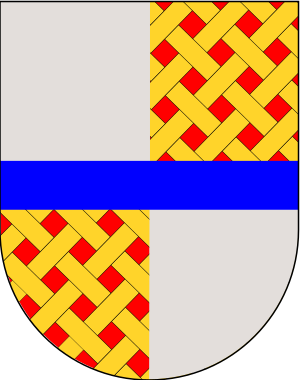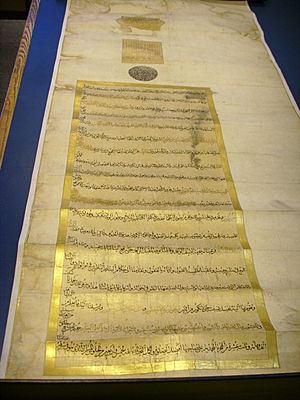Sir William Norris, 1st Baronet facts for kids
Sir William Norris (born around 1658 – died 10 October 1702) was an important English diplomat and politician. A diplomat is someone who represents their country in another country. A politician helps make laws for their country. Sir William was a member of the House of Commons, which is like a parliament where laws are debated. He served there from 1695 to 1701.
He also worked for the East India Company, a powerful trading company. He was even sent as an ambassador to the great Mughal Emperor Aurangzeb in India. An ambassador is a high-ranking diplomat. His family name is sometimes spelled Norres or Norreys.
Contents
Sir William Norris's Early Life
Family Background
William Norris was the second son of Thomas Norris. His family lived at Speke Hall in Lancashire, England. His mother was Katherine, the daughter of Sir Henry Garraway.
William's older brother, Thomas Norris (1653–1700), was also a politician. Thomas was a Whig Member of Parliament (MP) for Liverpool from 1688 to 1695.
Becoming a Politician
When his brother Thomas left Parliament in 1695, William took his place. He became the MP for Liverpool and held this position until 1701. Even when he was away in India, he was re-elected. However, he later lost his seat after a special review.
On 3 December 1698, William Norris was given a special title: he became a baronet. This is a title of honour, like a knight, but it can be passed down in the family. He was known as the 1st Baronet of Speke, Lancashire. Sadly, he had no children, so the title ended when he died.
Sir William's Mission to India
Why He Went to India
In 1698, a new company called the "English Company" (also known as the "New East India Company") was formed. This company wanted to trade in the East Indies, which included India. To do this, they needed permission from the Mughal Emperor Aurangzeb.
So, Sir William Norris was chosen for this important job. He was made a baronet especially for this mission. He traveled to India on a warship and was paid a large salary by the company. His main goal was to get special trading rights and protection from the Mughal authorities for the new company.
This was a big challenge because the "Old East India Company" had been trading in India for a long time. They already had special permissions, called firmans, from the Mughal Emperors. The old company did not want competition.
Arrival in India
Sir William landed in India on 25 September 1699, at a place called Masulipatam on the east coast. He met Consul Pitt, who worked for the English Company there.
The situation was tricky. Another representative of the English Company, Sir Nicholas Waite, had already written to Emperor Aurangzeb. Waite had asked for trading rights and offered to stop pirates in the Indian seas. However, the English Company was not actually able to stop the pirates.
Sir William had some difficulties. His interpreter, Niccolao Manucci, said he couldn't help. Consul Pitt also hadn't prepared for the long journey inland. Sir William and Pitt disagreed, so Sir William sailed to Swally (Suvali), a port near Surat, arriving on 10 December 1700.
Journey to Meet the Emperor
Sir William made a grand entrance into Surat. On 27 January 1701, he began his long journey to meet Emperor Aurangzeb. The Emperor's camp was far away, south of Burhanpur.
Sir William traveled with over sixty Europeans, including his younger brother Edward Norris, and three hundred Indians. They traveled about 470 miles across Maharashtra, through cities like Daulatabad and Aurangabad. The journey took 38 days, and they reached Burhanpur on 6 March.
While in Burhanpur, Sir William refused to meet Asad Khan, the Emperor's chief minister. He wanted to meet the Emperor directly. He continued south to Panhala fort, where the Emperor was leading a siege. Sir William arrived nearby on 4 April.
Meeting Emperor Aurangzeb
Sir William finally had an audience with Emperor Aurangzeb on 28 April. He presented a letter from King William of England in a fancy ceremony, along with many gifts.
During their talks, Emperor Aurangzeb focused on the offer to stop piracy in the Indian Ocean. This was very important because pirates attacked ships carrying pilgrims going on the hajj (a religious journey). Sir William, however, could not give strong enough promises to stop the pirates.
This issue became a major problem. Even though both the Old and New East India Companies gave large gifts of money, Sir William left without getting the special permissions he needed. He felt his interpreter, Adiell Mill, who wasn't an expert in Persian, made things harder.
He left the Emperor's camp on 5 November 1701. He was then held up in Burhanpur for some time.
The Journey Home
In February 1702, Emperor Aurangzeb sent Sir William a letter and a sword for King William. The Emperor also promised that the firmans (permissions) would be sent later.
On 9 February, Sir William started his journey back. He arrived near Surat on 12 March. He then had a big argument with Sir Nicholas Waite, blaming him for the mission's failure.
Sir William Norris's Death
On 5 May 1702, Sir William Norris sailed for England on a ship called the Scipio. His brother Edward and his team sailed on another ship, the China Merchant.
The two ships met at Mauritius on 11 July. But soon after, the Scipio separated from the other ship. When the Scipio reached St. Helena, it was reported that Sir William Norris had become very sick with dysentery. He died at sea on 10 October 1702.
Sir William was married to a woman who was the widow of a man named Pollexfen. However, he did not have any children.



